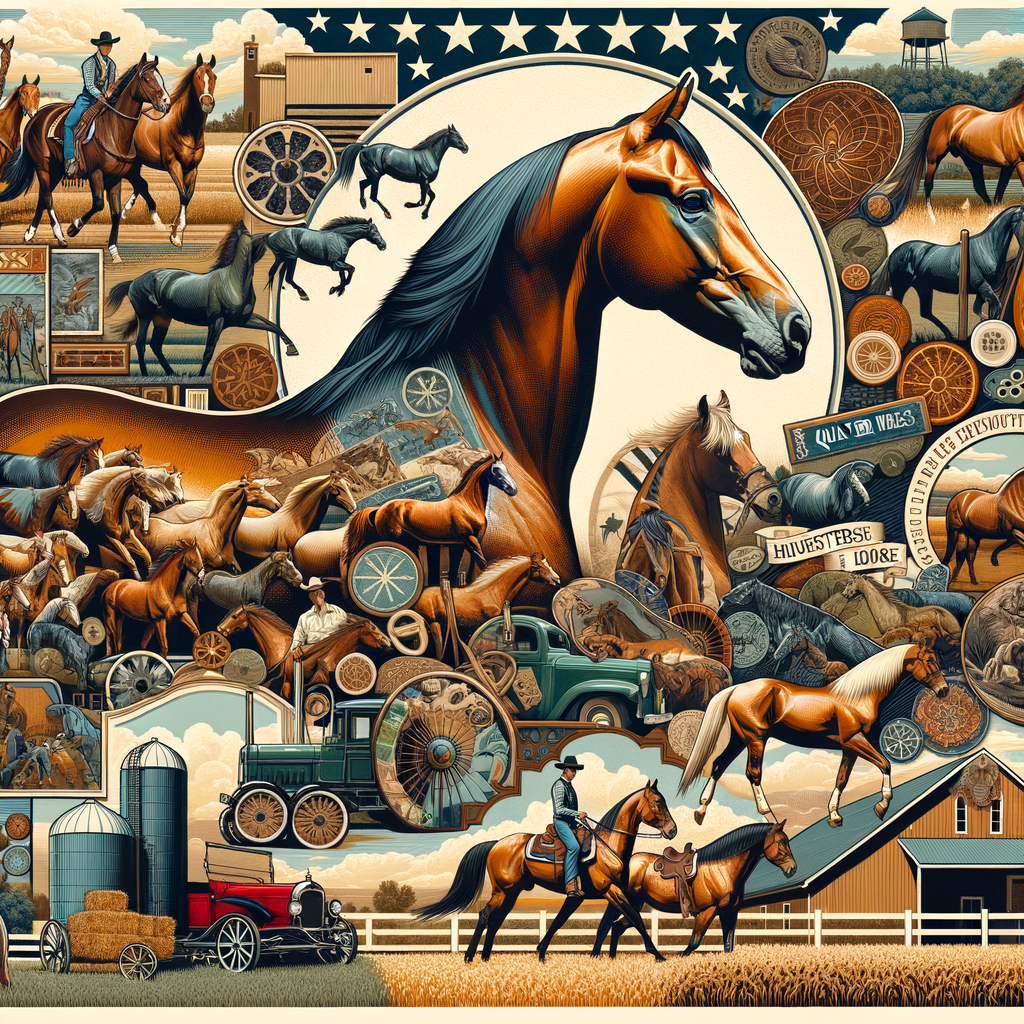
Introduction to the Legacy of Quarter Horses
Welcome to the fascinating world of Quarter Horses. These remarkable creatures are not just horses; they are a legacy. In this post, we will delve into the breed’s overview and understand the legacy they’ve created over the years.
- Overview of the Quarter Horses breed
Quarter Horses are a breed of horses known for their incredible speed over short distances. They get their name from their ability to outrun other horse breeds in races of a quarter mile or less. This breed is not just about speed; they are also known for their calm and docile nature, making them perfect for both work and companionship.
These horses are muscular, with a broad chest and powerful hindquarters, which contribute to their speed. They are typically between 14 and 16 hands high, and they can come in any color, with chestnut being the most common.
What makes Quarter Horses truly special is their versatility. They excel in a variety of equestrian activities beyond racing, including rodeo events, horse shows, and as working ranch horses. They are also popular as family pets and therapy animals due to their gentle nature.
| Height | Color | Characteristics |
|---|---|---|
| 14-16 hands | Any (Chestnut most common) | Muscular, Broad chest, Powerful hindquarters |
- Understanding the Quarter Horse legacy
The legacy of Quarter Horses is deeply intertwined with the history of America. They have been a part of the American landscape since the 1600s, when English colonists bred imported English Thoroughbred horses with native horses. The result was a fast, hardy horse that could work on a farm during the week and race on the weekends.
As America expanded westward, so did the Quarter Horse. They were the horse of choice for cowboys, settlers, and pioneers. Their speed and agility made them perfect for cattle work, while their calm and friendly nature made them beloved family pets.
Today, the Quarter Horse is the most popular breed in the United States, with over 3 million registered in the American Quarter Horse Association. Their legacy continues to grow as they excel in a variety of fields, from racing and rodeo to therapy and companionship.
In conclusion, the Quarter Horse is more than just a breed; it’s a symbol of America’s past, present, and future. Their legacy is a testament to their versatility, resilience, and the enduring bond between humans and horses.
History of Quarter Horses
Let’s take a journey back in time to discover the rich history of Quarter Horses. This breed has a fascinating story that is deeply intertwined with American history.
Origins of Quarter Horses
The origins of Quarter Horses are as interesting as the breed itself. Let’s delve into the early history and development of this breed and its role in American history.
- Early history and development of the breed
- Role of Quarter Horses in American history
The Quarter Horse breed traces its roots back to the 1600s. English settlers in Virginia introduced Thoroughbred horses to native horses, resulting in a breed known for its speed and agility. The name ‘Quarter Horse’ comes from the breed’s ability to outrun other horse breeds in races of a quarter mile or less. This breed was not only fast but also hardy and versatile, making it ideal for the hard work required in the new colonies.
Quarter Horses played a significant role in American history. They were the preferred mount of cowboys in the Wild West due to their speed, strength, and intelligence. These horses were instrumental in cattle drives, a critical part of the American economy in the 19th century. Furthermore, Quarter Horses served in the cavalry during the American Civil War, demonstrating their courage and resilience.
In conclusion, the history of Quarter Horses is a testament to their strength, speed, and versatility. These qualities have made them an integral part of American history and continue to make them popular today.
Quarter Horses in the 20th Century
The 20th century brought about significant changes in the world of Quarter Horses. These changes were driven by advancements in breeding techniques and technology. Let’s explore these changes in detail.
- Changes in breeding and use
- Impact of technology on Quarter Horses lineage
During the 20th century, the breeding and use of Quarter Horses underwent a transformation. Earlier, these horses were primarily used for work on ranches and farms. However, as the century progressed, their role shifted towards recreational riding and competitive sports. This change in use led to a shift in breeding practices as well.
Instead of breeding for strength and endurance, breeders started focusing on speed, agility, and temperament. This shift resulted in the Quarter Horse we know today – a versatile breed that excels in a variety of equestrian sports.
Technology has played a significant role in shaping the lineage of Quarter Horses in the 20th century. With the advent of genetic testing, breeders were able to make more informed decisions about their breeding programs.
Genetic testing allowed breeders to identify potential health issues, determine parentage, and even predict certain traits in foals. This technology has greatly improved the quality of the breed and has helped to preserve the Quarter Horse’s unique characteristics.
| Change | Impact |
|---|---|
| Shift in use | From work horses to recreational and competitive sports horses |
| Changes in breeding practices | Focus on speed, agility, and temperament |
| Advent of genetic testing | Improved quality of breed and preservation of unique characteristics |
In conclusion, the 20th century was a period of significant change for Quarter Horses. The shift in use and advancements in technology have shaped the breed into what it is today – a versatile, agile, and beloved horse breed.
Legendary Quarter Horses
Over the years, Quarter Horses have made a significant impact in the equestrian world. Let’s take a closer look at some of these legendary horses and their contributions to the breed’s legacy.
Iconic Quarter Horses in History
There are several Quarter Horses that have left an indelible mark on history. Here, we will profile some of these famous horses and explore their contributions to the breed’s legacy.
- Profiles of famous Quarter Horses
- Contributions of these horses to the breed’s legacy
| Name | Years Active | Key Achievements |
|---|---|---|
| Wimpy | 1937-1959 | First horse registered by the American Quarter Horse Association (AQHA), setting the standard for the breed. |
| Easy Jet | 1967-1992 | Won the All American Futurity, the world’s richest Quarter Horse race, and sired more than 1,500 foals. |
| Impressive | 1969-1995 | Known for his muscular build and symmetry, he revolutionized the breed’s conformation standards. |
The contributions of these iconic Quarter Horses to the breed’s legacy are immense. Wimpy, for instance, set the standard for the breed, influencing its physical characteristics and performance abilities. Easy Jet, on the other hand, demonstrated the breed’s speed and endurance, winning one of the most prestigious races in the world. Lastly, Impressive, with his muscular build and symmetry, revolutionized the breed’s conformation standards, influencing how Quarter Horses are bred and judged today.
These legendary horses have not only excelled in their respective fields but also significantly shaped the Quarter Horse breed. Their influence continues to be felt today, underscoring the enduring legacy of these iconic Quarter Horses.
Influential Quarter Horses in Popular Culture
Quarter Horses have made a significant impact in popular culture, particularly in film and literature. Their unique characteristics and abilities have made them a favorite among writers and filmmakers, contributing to their popularity and recognition.
- Depictions of Quarter Horses in Film and Literature
- Impact of These Representations on the Breed’s Popularity
Quarter Horses have been featured in numerous films and books, often portrayed as loyal companions or skilled athletes. In the 1950 film “The Palomino”, a Quarter Horse named Golden Cloud played the lead role, showcasing the breed’s versatility and intelligence. In literature, the Quarter Horse has been immortalized in Marguerite Henry’s “Misty of Chincoteague” series, where the breed’s speed and endurance are highlighted.
The depiction of Quarter Horses in popular culture has significantly influenced the breed’s popularity. Their portrayal as reliable, hardworking, and versatile horses has attracted many horse enthusiasts and potential owners. According to the American Quarter Horse Association, the breed is now the most popular in the United States, with over 3 million registered Quarter Horses. This popularity can be attributed in part to their representation in film and literature, which has helped to spread awareness and appreciation for the breed.
| Medium | Example | Impact |
|---|---|---|
| Film | “The Palomino” | Highlighted the breed’s versatility and intelligence |
| Literature | “Misty of Chincoteague” series | Emphasized the breed’s speed and endurance |
In conclusion, the portrayal of Quarter Horses in popular culture has played a significant role in promoting the breed. Their representation in film and literature has not only entertained audiences but also educated them about the breed’s unique qualities and capabilities, contributing to their popularity and recognition.
Quarter Horses Today
Current Status of the Breed
The Quarter Horse, known for its speed and versatility, continues to be a popular breed today. This breed is not only cherished for its historical significance but also for its modern-day uses and breeding trends.
- Modern uses of Quarter Horses
- Current trends in Quarter Horses breeding
Today, Quarter Horses are used in a variety of ways. They are popular in both English and Western riding disciplines. Their speed and agility make them perfect for rodeo events such as barrel racing, calf roping, and team penning. In addition, their calm demeanor and sturdy build make them excellent trail and pleasure riding horses. They are also used in therapeutic riding programs, helping people with physical and mental challenges.
When it comes to breeding, the focus is on maintaining the Quarter Horse’s unique characteristics while improving its health and performance. Breeders are using advanced technologies to ensure the genetic health of the breed. There is a trend towards breeding Quarter Horses with a balanced conformation, good temperament, and strong athletic abilities. Also, there is an increasing interest in preserving the bloodlines of the foundation Quarter Horses, those that were the original registered Quarter Horses.
In conclusion, the Quarter Horse breed continues to thrive in the modern world, thanks to its versatility and the efforts of dedicated breeders. Whether it’s in the rodeo arena, on a peaceful trail, or in a therapeutic riding program, the Quarter Horse is a testament to the enduring legacy of this remarkable breed.
Preserving the Quarter Horses Heritage
As we delve into the present-day scenario of Quarter Horses, it is important to acknowledge the efforts made to preserve the rich heritage of this breed. The preservation of the Quarter Horses heritage is a collective responsibility that involves maintaining the breed’s tradition and the active role of various organizations.
- Efforts to maintain the breed’s tradition
- Role of organizations in preserving the Quarter Horses heritage
The tradition of Quarter Horses is deeply rooted in their history, dating back to the 1600s. Over the years, breeders, trainers, and enthusiasts have made concerted efforts to maintain the breed’s tradition. These efforts include preserving the unique characteristics of the breed such as their muscular build, compact body, and exceptional speed over short distances. Breeders also strive to maintain the Quarter Horses’ versatility, ensuring they excel in a variety of tasks from racing to ranch work.
Organizations play a pivotal role in preserving the Quarter Horses heritage. The American Quarter Horse Association (AQHA), for instance, has been instrumental in this regard. The AQHA not only registers and tracks Quarter Horses but also promotes the breed through various events and shows. They have also established strict breeding guidelines to ensure the preservation of the breed’s unique traits. Other organizations like the National Quarter Horse Registry and the Foundation Quarter Horse Association also contribute significantly to the preservation of the breed’s heritage.
In conclusion, preserving the Quarter Horses heritage is a task that requires dedication and concerted efforts from breeders, trainers, enthusiasts, and organizations alike. It is through these efforts that the legacy of the Quarter Horses continues to thrive in the present day.
Conclusion: The Enduring Legacy of Quarter Horses
The Quarter Horse, with its rich history, has left an indelible mark on our culture and society. Its legacy is not just about its speed or strength, but also about the values it embodies – resilience, loyalty, and versatility.
- Summary of the Quarter Horses’ historical and cultural impact
- Future prospects for the breed
The Quarter Horse has been a part of American history since the 1600s. Its name comes from its ability to outrun other horse breeds in races of a quarter mile or less. This breed has been a symbol of the American West, often depicted in movies and literature as the trusted companion of cowboys.
Over the years, Quarter Horses have been used for various purposes – from farm work to rodeo events, and even therapy for individuals with disabilities. Their versatility and gentle nature have made them a favorite among horse enthusiasts.
According to the American Quarter Horse Association, there are over 3 million registered Quarter Horses worldwide, making it one of the most popular horse breeds. This is a testament to their enduring appeal and cultural significance.
The future of the Quarter Horse breed looks promising. With continued breeding programs and preservation efforts, the Quarter Horse is expected to maintain its popularity. Advances in equine science and technology also offer exciting possibilities for improving the health and performance of these horses.
Moreover, the Quarter Horse continues to be a favorite in various equestrian sports. Its agility and speed make it a top choice for events like barrel racing and reining. Its calm demeanor also makes it suitable for therapeutic riding programs, contributing to its increasing demand.
In conclusion, the Quarter Horse has a rich and enduring legacy that continues to influence our society. Its historical and cultural impact is evident, and its future prospects are bright. The Quarter Horse is more than just a breed – it’s a symbol of our shared history and a testament to our love for these magnificent creatures.









